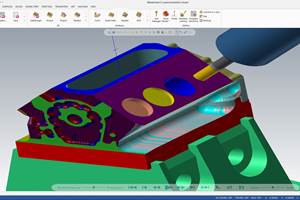Software Streamlines Mold Production
The design and manufacture of injection mold tooling for plastics connectors can be extremely complicated, with many of the forms, profiles and angles required on these small components being particularly intricate.
The Alan Group, based in Horsham, Sussex (Great Britain), comprises four companies and is acknowledged as one of Europe’s leading plastics engineering and injection molding specialists. Almost 80 percent of its production of tools and components is directly exported.
Two companies in the group are FineMoulds and Alan Grinders. The latter employs 55 people and has experience in the production of tools and molds for small electrical and electronic connectors used in computers and telephones. FineMoulds produces injection molded parts for a wide range of customers.
The design and manufacture of injection mold tooling for plastics connectors can be extremely complicated, with many of the forms, profiles and angles required on these small components being particularly intricate. Tolerances are as tight as 5 microns and the complete multi-impression tooling, which can have up to eight cavities, must be capable of consistent production of millions of parts.
Virtually all the connectors produced have pins or slots arranged to enable the physical connection to be made. This means the injection molding of such slender features, on parts as small as 12 mm by 3 mm, requires sophisticated tooling with high attention to detail, which prolonged time spent programming and machining.
However, following the recent installation of an EdgeCAM off-line programming system from Pathtrace Engineering Systems (Ontario, California) The Alan Group has been able to streamline the production of electrodes and multi-cavity molds.
EdgeCAM is used to program two vertical machining centers: Mikron WF 31 D and BostoMatic 32GS. These are used to produce a wide range of electrodes, bolster plates, inserts, cavities and various parts for gates and runner systems.
Compared with manual data input routines, through the use of macro canned cycles at the machine control, EdgeCAM already has cut programming time by up to 50 percent on complex ejector plate work, and by around a third on a number of insert plates and certain styles of electrodes. The change has reduced some 6-hour machining cycles to just 2 hours.
In addition, the software enabled the company to accept more complex tooling assignments, such as the machining of intricate pitched electrodes used for the progressive erosion of fine features. One such tool, which looks like a thick comb with offset teeth, involves machining 60 slender upstands from a solid 20 mm by 30 mm by 300 mm copper block.
Each upstand is extremely fine, being just 0.4 mm diameter, and over its 16 mm length has to be accurate to within 0.01 mm. Prior to the installation of EdgeCAM, the electrode would have been progressively built up from separate elements. Now, the entire tool can be programmed in just 60 minutes using the step and repeat area clearance routines that support islands.
The machining of complex, copper runner-electrodes on a vertical machining center also has been optimized, and it now takes around 2 hours, as opposed to 5 or 6 when the electrodes were ground using rotary wheel dressers to generate the stubby, truncated gear tooth form geometry.
By hard metal machining at spindle speeds of 16,000 rpm, small parts such as cores for mold gates can be completely roughed out prior to finish machining using the solid sink vertical EDM. This revised dual operation process is quicker and more economic than the many hours previously allowed for eroding the complete cavity.
Not only is the software used on tool and mold production—EdgeCAM also has opened other subcontract machining opportunities. Alan Grinders is attracting business now from the Formula 1 motor racing sector. In fact, it was one such motor sport component that helped convince Alan Grinders that EdgeCAM was the best programming system for the company.
Initially, Alan Grinders shortlisted four CAM systems from which two suppliers were asked to provide demonstrations. “It seemed logical to use the F1 component for the evaluation process,” says CNC programmer Glen Fowler. “This particular fuel system component had a 50-mm2 bell-shaped housing that involved machining complex 3D profiles along with quite intricate internal filets, radii and chamfers. If I manually programmed this job, it would have taken me the best part of a week.”
While both CAM systems produced a program for this job, the speed and simplicity of EdgeCAM impressed Alan Grinders. “EdgeCAM created the basic model in a little over 5 minutes and the complete program was up and ready to run within the hour,” Mr. Fowler says.
Related Content
CAD/CAM System Requirements: An Overview
CAD/CAM programs are among the most demanding kinds of computer software. Smooth operation requires careful consideration of computer specifications.
Read MoreIMTS Takeaways From the Modern Machine Shop Editorial Team
The first in-person IMTS in four years left the MMS editorial staff with a lot to digest. Here are a few of our takeaways from the show floor.
Read MoreFearless Five-Axis Programming Fosters Shop Growth
Reinvestment in automation has spurred KCS Advanced Machining Service’s growth from prototyping to low-and mid-volume parts. The key to its success? A young staff of talented programmers.
Read MoreFinally, A Comprehensive Software Solution Designed for Small Job Shops
Zel X from Siemens is an integrated software application that consolidates collaboration, design, manufacturing, and operations into a comprehensive, easy-to-use solution. From RFQ to delivery, it’s a more efficient way to handle quotes, manage jobs, make parts, and collaborate with teams of all sizes.
Read MoreRead Next
The Cut Scene: The Finer Details of Large-Format Machining
Small details and features can have an outsized impact on large parts, such as Barbco’s collapsible utility drill head.
Read More3 Mistakes That Cause CNC Programs to Fail
Despite enhancements to manufacturing technology, there are still issues today that can cause programs to fail. These failures can cause lost time, scrapped parts, damaged machines and even injured operators.
Read More












.png;maxWidth=300;quality=90)


.png;maxWidth=300;quality=90)









